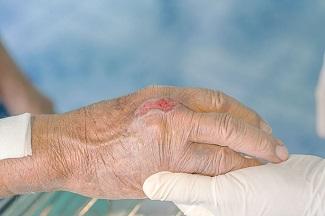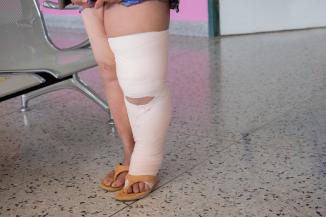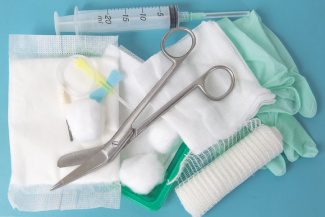Thoughts on Patient Education and Wound Cleansing
February 27, 2020
As patient-driven groupings model hits home care, patients or their caregivers will be expected to do more of the care. Subsequently, nursing staff are expected to provide more education, making "how to" information more crucial than ever.
Products Available to Patients and the Need for Education
Some wound care companies supply simple how-to video clips with their dressing supplies. The supplies come with either a DVD or a card player that demonstrates performing a dressing change. Home care agencies could learn from this practice, as they certainly need to start providing patients with well-documented education and information, but ensuring that the education is of good quality may be a difficult task.
Education is not always sufficient, as people need to believe what they are being told. Informing someone to use the normal saline provided to them for wound cleansing when they "know" hydrogen peroxide is an effective wound cleanser means that the task of education becomes a daunting one. After all, they have always used hydrogen peroxide, as did their mother and her mother, too. In fact, it is sold in the local pharmacy, and the sales associate there says it works really well. Looking hydrogen peroxide up online will only further compound the belief that it should be used for wound cleansing.
I needed some 70% alcohol recently, and so I went to the pharmacy section of the store. While there, I noticed the rubbing alcohol on the shelf. It made me look at some of the other products, and it drew to my attention again to the difference between what the patient of a home health agency needs and what is available in their local pharmacy. I was going to ask a member of the staff what the rubbing alcohol was for, but there was no one around. The person at the checkout said it "wasn't her row." I looked at the various antiseptics, hydrogen peroxide, and antibiotic creams and then the BandAids impregnated with antibiotics, open on two sides. The BandAids for children had dinosaurs on them and some odd-looking sponge character, and I wondered at the cost of it all. Is it not time for the donuts, the hydrogen peroxide, and the rubbing alcohol to go and for some proper guidance on what we should be doing for simple cuts, scrapes, and burns?
Then I noticed the tube of honey and thought about the food coop and the raw honey they sell. Oh dear, I wonder if they realize that any Clostridium spores (not that uncommon in raw honey, and that's why it is not recommended for babies) would cause gas gangrene if placed in a wound. When I got home, I had an email from a friend who had read the recent blog on wound cleansing on WoundSource and wanted me to comment on it. Initially, I was surprised at the article, and then I thought back to the pharmacy and all of the options people have.
Historical Wound Cleansing Products
A long time ago, to stop people from putting inappropriate products into wounds, it was common to hear that something should go in a wound only if it can comfortably go in the eyes. Personally, I found this a useful way of preventing the doctors I worked with from requesting we clean wounds with bleach, alcohol, Maalox, and chlorhexidine hand soap or anti-dandruff shampoo. It didn't help with the request to cover a wound with egg white, but that got stopped when Salmonella species were found in a significant number of eggs, which made the practice more obviously questionable.
The Need for Clarity on Wound Cleansing Products
As a wound care nurse, I have options and a formulary to choose from and don't need to use soap and water for wound cleansing. As a patient, it is not easy to purchase normal saline, although, provided you have the money, it does come in a fancy spray with a silly price tag, considering it is just saltwater. If you go into any pharmacy, you can purchase hydrogen peroxide and other antiseptics for wound care, and yes, they are costly, as well as probably detrimental. Researching which liquid soap works best and interferes with wound healing the least may well be a worthwhile project.
I have used most of the detergent-based sprays on the market and have noticed that many can cause stinging and wound pain—why is this? I like the detergent cleansers for dirty wounds, and, like the author of the aforementioned blog, "I think" they clean the wound better than saline, but do they? Dirty, sloughy wounds often need to have an enzymatic debriding agent used as a daily dressing, but many detergents and soaps will denature proteins, preventing enzymatic debriding agents from functioning optimally.1
It is not unusual to have these products ordered together, or for the bedside clinician to use a detergent spray instead of the saline ordered; both scenarios pinpoint the importance of clinician education, especially for those actually performing the wound care. Providing proper, thorough education on how to use products to ensure best possible outcomes for our patients is fundamental.
Misinformation and Contradictory Advice on the Internet
If you go online and ask how to clean a wound, there are many options and as many contradictions. On the page I saw from Web MD, there is a bottle of hydrogen peroxide being poured onto gauze; however, reading through the text, it says to use fresh water and not hydrogen peroxide or soap. We have patients discharged from hospitals with orders to wash their wounds with soap and water, but the ordering clinicians don't see the bars of soap I see or the showers in an exceptionally dubious state of hygiene.
One web page I saw was describing the healing powers of essential oils. I have seen a major problem caused by pure tea tree oil being used on a venous leg ulcer. It took me three visits to work out that after I left, the daughter would unwrap the patient's leg and place 10 drops of undiluted, high-quality essential oil on her mother's wound, replace the foam dressing, and replace the padding and Coban (do you know how hard it is to unwrap Coban and re-use it?!).
Conclusion
There are no easy answers, especially when colleagues put their own beliefs and inspirational ideas out there in the form of discharge instructions and corporations can make money out of a can of saltwater. I suppose sticking to "if it stings or irritates, stop using it" might be a sensible approach to take. Who would have thought I would still be saying this after 40 years of cleaning wounds!
References
1. Collagenase SANTYL ointment compatibility with commonly used wound care products. Smith and Newphew. https://santyl.com/hcp/compatibility Accessed February 28, 2020.
About the Author
Margaret Heale has a clinical consulting service, Heale Wound Care in Southeastern Vermont and draws on her extensive experience as a wound, ostomy and continence nurse in acute and long-term care settings to provide education and holistic care in her practice.
The views and opinions expressed in this blog are solely those of the author, and do not represent the views of WoundSource, HMP Global, its affiliates, or subsidiary companies.













Follow WoundSource
Tweets by WoundSource